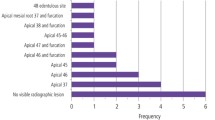Abstract
Background and Objectives
The purpose of this prospective study was to evaluate the incidence and various risk factors influencing the sensory deficit in case of lingual nerve injury (LNI) in individuals whose impacted mandibular third molars are surgically removed under local anesthesia.
Materials and Methods
The study was based on the data collected prospectively from a random group of 100 patients who underwent surgical removal of bony impacted lower third molar in a dental hospital. Details of the patient, reason for extraction, type of impaction, method of surgery and signs and symptoms of nerve injury are recorded. Neurosensory testing was done to evaluate the LNI at 1 week, 1 months, 3 months and 6 months interval. Comparison was carried out using Chi square test. For all tests a P < 0.05 was considered significant.
Results
The incidence of LNI was 4 % and of temporary in nature which recovered well within 6 months postoperatively. The age of the patient above 26 years, lingual flap retraction, depth of impaction (red line ≥10 mm) and duration of surgery above 30 min were the significant factors for causing LNI.
Conclusions
The age of the patient, depth of impaction, lingual flap retraction and longer duration of surgery are significant risk factors for LNI during mandibular third molar surgery. Greater care should be taken to avoid the morbidity and patients should be informed well ahead about the probable complications.
Similar content being viewed by others
References
Shepherd JP, Brickley M (1994) Surgical removal of third molars. BMJ 309:620–621
Kandasamy S, Rinchuse DJ, Rinchuse DJ (2009) The wisdom behind third molar extractions. Aust Dent J 54:284–292
Blondeau F, Daniel NG (2007) Extraction of impacted mandibular third molars: postoperative complications and their risk factors. J Can Dent Assoc 73:325
Osborn TP, Frederickson G Jr, Small IA, Torgerson TS (1985) A prospective study of complications related to mandibular third molar surgery. J Oral Maxillofac Surg 43:767–769
Brann CR, Brickley MR, Shepherd JP (1999) Factors influencing nerve damage during lower third molar surgery. Br Dent J 186:514–516
Bui CH, Seldin EB, Dodson TB (2003) Types, frequencies, and risk factors for complications after third molar extraction. J Oral Maxillofac Surg 61:1379–1389
Susarla SM, Blaeser BF, Magalnick D (2003) Third molar surgery and associated complications. Oral Maxillofac Surg Clin N Am 15:177–186
Loescher AR, Smith KG, Robinson PP (2003) Nerve damage and third molar removal. Dent Update 30:375–382
Lopes V, Mumenya R, Feinmann C, Harris M (1995) Third molar surgery: an audit of the indications for surgery, post-operative complaints and patient satisfaction. Br J Oral Maxillofac Surg 33:33–35
Gomes AC, Vasconcelos BC, de Oliveira e Silva ED, da Silva LC (2005) Lingual nerve damage after mandibular third molar surgery: a randomized clinical trial. J Oral Maxillofac Surg 63:1443–1446
Robinson PP (1997) Nerve injuries resulting from the removal of impacted teeth. In: Andreasen JO, Peterson JK, Laskin DM (eds) Textbook and colour Atlas of tooth impaction. Munksgaard, Copenhagen, pp 469–490
Howe GL (1996) Minor oral surgery. Varghese Publishing House, Mumbai, pp 109–143
Fonseca RJ, Barber HB, Mathewson JD (2000) Oral and Maxillofacial Surgery, Vol 1. W.B. Saunders Company, St Lousis, pp 185–211
Robinson PP, Smith KG, Johnson FP, Coppins DA (1992) Equipment and methods for simple sensory testing. Br J Oral Maxillofac Surg 30:387–389
Robinson PP, Smith KG (1996) Lingual nerve damage during lower third molar removal: a comparison of two surgical methods. Br Dent J 180:456–461
Carmichael FA, McGowan DA (1992) Incidence of nerve damage following third molar removal: a west of Scotland oral surgery research group study. Br J Oral Maxillofac Surg 30:78–82
Renton T, McGurk M (2001) Evaluation of factors predictive of lingual nerve injury in third molar surgery. Br J Oral Maxillofac Surg 39:423–427
Gülicher D, Gerlach KL (2001) Sensory impairment of the lingual and inferior alveolar nerves following removal of impacted mandibular third molars. Int J Oral Maxillofac Surg 30:306–312
Jerjes W, Upile T, Shah P, Nhembe F, Gudka D, Kafas P et al (2010) Risk factors associated with injury to the inferior alveolar and lingual nerves following third molar surgery-revisited. Oral Surg Oral Med Oral Pathol Oral Radiol Endod 109:335–345
Cheung LK, Leung YY, Chow LK, Wong MC, Chan EK, Fok YH (2010) Incidence of neurosensory deficits and recovery after lower third molar surgery: a prospective clinical study of 4,338 cases. Int J Oral Maxillofac Surg 39:320–326
Mason DA (1988) Lingual nerve damage following lower third molar surgery. Int J Oral Maxillofac Surg 17:290–294
Pogrel MA, Goldman KE (2004) Lingual flap retraction for third molar removal. J Oral Maxillofac Surg 62:1125–1130
Baqain ZH, Abukaraky A, Hassoneh Y, Sawair F (2010) Lingual nerve morbidity and mandibular third molar surgery: a prospective study. Med Princ Pract 19:28–32
Blackburn CW, Bramley PA (1989) Lingual nerve damage associated with the removal of lower third molars. Br Dent J 167:103–107
Gargallo-Albiol J, Buenechea-Imaz R, Gay-Escoda C (2000) Lingual nerve protection during the surgical removal of lower third molar: a prospective randomised study. Int J Oral Maxillofac Surg 29:268–271
Pichler W, Beirne OR (2001) Lingual flap retraction and prevention of lingual nerve damage associated with third molar surgery: a systematic review of the literature. Oral Surg Oral Med Oral Pathol Oral Radiol Endod 91:395–401
Author information
Authors and Affiliations
Corresponding author
Rights and permissions
About this article
Cite this article
Charan Babu, H.S., Reddy, P.B., Pattathan, R.K.B. et al. Factors Influencing Lingual Nerve Paraesthesia Following Third Molar Surgery: A Prospective Clinical Study. J. Maxillofac. Oral Surg. 12, 168–172 (2013). https://doi.org/10.1007/s12663-012-0391-5
Received:
Accepted:
Published:
Issue Date:
DOI: https://doi.org/10.1007/s12663-012-0391-5




